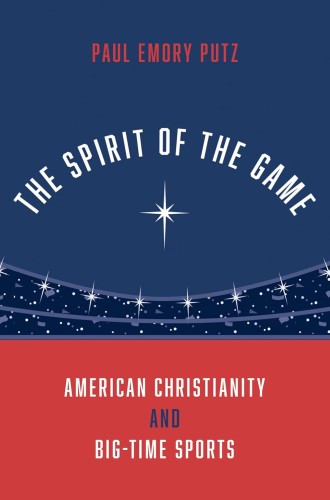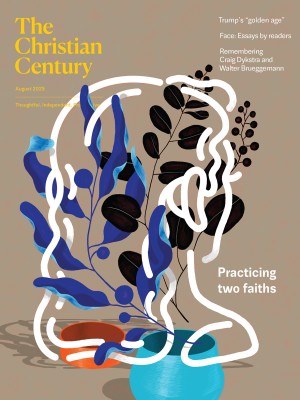A history of muscular Christianity in the US
Paul Putz traces the influence of evangelicalism on sports, from the birth of the YMCA to Colin Kaepernick.

The Spirit of the Game
American Christianity and Big-Time Sports
Paul Emory Putz, who directs Baylor University’s Faith and Sports Institute, has spoken of his appreciation for the faith-forming, character-building influence the Fellowship of Christian Athletes had on his life when he played high school basketball in Nebraska. In The Spirit of the Game, Putz magnifies that personal appreciation into a wide-ranging historical study aimed at showing the evolution of the Christian athlete movement in America through the 20th century and into the present day.
An ancestor of muscular Christianity in America, the Young Men’s Christian Association began in London in 1844, rooted in the conviction that vigorous physical recreation and competitive sports were as vital to the development of Christian men as spiritual and intellectual training. In 1889, Luther Gulick, a director at the International YMCA Training School in Springfield, Massachusetts, wrote that “by means of the physical, men are brought under the influence of the spiritual . . . and it is the spiritual that teaches men that their bodies are sacred to noble ends.” Two years later, one of Gulick’s graduate students, James Naismith, designed a game he called “basket ball” as a Christian recreation.
Read our latest issue or browse back issues.
After World War I, college football and professional baseball spread across the American cultural landscape, supported by increasing attention from developing media: newspapers, magazines, newsreels, and radio. Amos Alonzo Stagg, a University of Chicago football coach, and Branch Rickey, a Major League Baseball player and team executive, planted seeds of what would become a cultural garden of Christian morality and virtue within the expansive fields of American sports. Stagg, a Yale college football player who was Naismith’s classmate at the YMCA training school and later became a coach and cultural influencer, translated the muscular Christian movement of 19th-century England to American college playing fields. As part of his Christian practice, Rickey refused to play or coach baseball games on Sunday.
In 1954, a junior college basketball coach named Don McClanen envisioned “an organization . . . for athletes and coaches . . . to speak and witness for Christ and the wholesome principles of good character and clean living to the youth of our nation.” Inspired by the down-to-earth editorial voices of Norman Vincent Peale’s Guideposts magazine, McClanen saw an opportunity to amplify the voices of upstanding celebrity sports stars for the guidance of young athletes who admired them. He reached out to 19 professional athletes, college football coaches, and Olympic medalists, asking for their support in the formation of a coalition of “Christian men . . . who happen to be more or less prominent in all sports” to help advance “Christian thinking among the youth of America.”
Drawing on Matthew Hedstrom’s 2012 book The Rise of Liberal Religion: Book Culture and American Spirituality in the Twentieth Century, Putz uses the phrase “middlebrow Christianity” to describe lay-led Protestant fellowships organized around athletics. The first American Christian sports movements, Putz argues, were created by White men in the Upper Midwest as a way of upholding and restoring traditional small-town values and practical Christianity to a nation that was falling in love with sports.
By the middle of the 20th century, the center of gravity for expressions of muscular Christianity shifted from an ethos of small towns in the Midwest to tones of burgeoning evangelical churches and ministries in the South. In 1976, the year born-again Christian Jimmy Carter was elected president, Newsweek published a cover article calling it “the year of the evangelical.” That same year, Sports Illustrated published a series of articles called “Religion in Sports.” The author, Frank Deford, coined the term Sportianity to describe the American mix of evangelical Christian faith and sports.
Putz ends his study of the complex relationship between Christianity and American sports with two celebrity employments of faith, each with a 20th-century Protestant heritage.
The homeschooled son of Baptist missionaries, University of Florida quarterback Tim Tebow represented a variety of southern evangelical piety not uncommon in the media-accelerated sports culture of the previous century. Accepting the Heisman Trophy as the outstanding college football player of 2007, Tebow praised his family, his coaches, fellow honorees, his teammates, and his personal Lord and Savior, Jesus Christ. In a post-presentation interview, he testified: If one puts God first and family second, good things will follow.
In 2016, NFL quarterback Colin Kaepernick, who was a member of the Fellowship of Christian Athletes at the University of Nevada, turned his celebrity status to silent protest of racial inequality and social injustice. With elaborations of spiritual dramas, scripture verses, and faith statements tattooed on his upper body, Kaepernick sat quietly on the bench or knelt, as in prayer, at the singing of the national anthem. When reporters asked him why he did not join his San Francisco 49ers teammates on the sidelines, Kaepernick said, “I am not going to stand up to show pride in a flag for a country that oppresses black people and people of color.”
In this extensively annotated book, Putz thoroughly covers his theme—from the 19th century, when participation in athletic activities was promoted as wholesome fellowship, to the madhouse commercial spectacles of our current mega-money sports scene. How much did the latter evolve from the former? Putz leaves that question for readers to debate.






